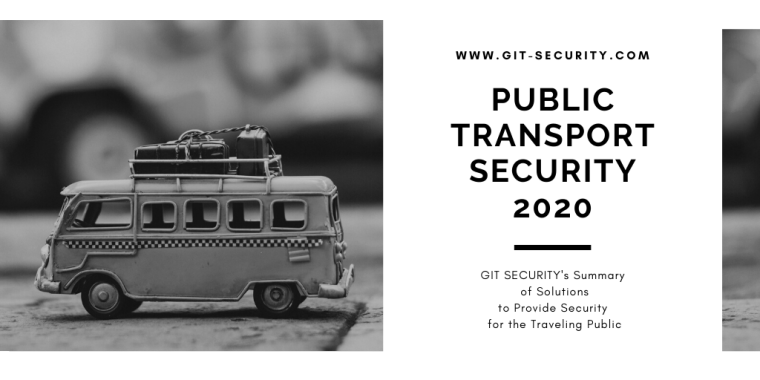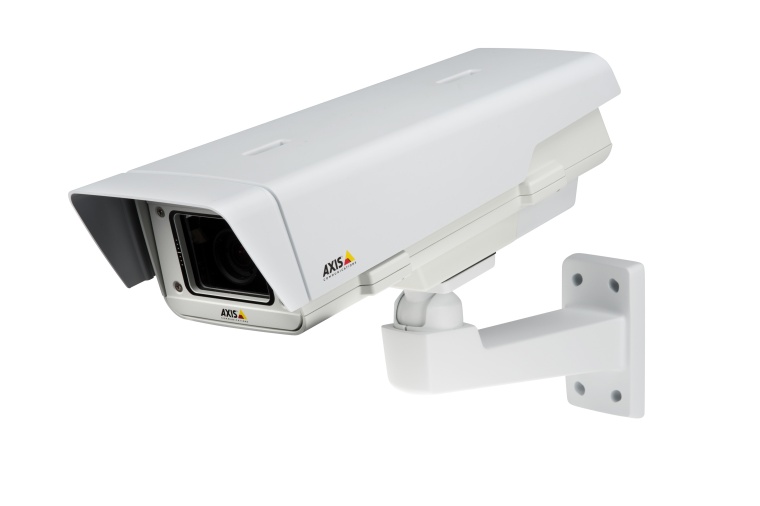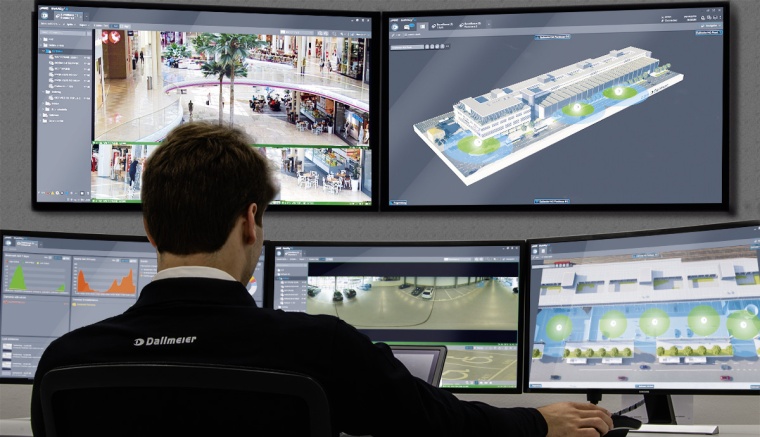Public Transport Security 2020





When evil minds want to spread their message and set about causing significant damage to property and people to get themselves noticed, security personnel can be one step ahead and prevent the worst happening. They are aided increasingly by intelligent surveillance methods that cope with the inhuman amount of decision-making that has to be done 24/7. GIT SECURITY has gathered some information about just a few of the components and solutions on the market that are ideal for securing public transport hubs.
The terrorist who plans an attack on the public transport infrastructure will not be an opportunist but rather someone who researches his – or her – target, obtains the necessary materials, possibly brings in like-minded individuals into the plan, and then puts the plan into action. All these actions leave traces that can be found and followed. Together, they can shed light on the intention, but can rarely all be coordinated to provide reasonably convincing evidence that such an attack is about to take place.
Well, that used to be the case. With the continual progression of artificial intelligence development, gathering all the elements mentioned above becomes a manageable task. If an AI system is fed with good information, it can analyze and predict much better than any team of people, no matter how large. And that is crucial to success in preventing such attacks – the gathering and input of good information. So the quality of video surveillance, movement analysis and system instructions is still going to decide how effective such an effort will be.
Video Surveillance of Public Places
The amount of public video surveillance that is already in operation, and that is tolerated by the general public, varies considerably from one country to the next. Sometimes it is discreetly installed so as not to alarm anyone; sometimes it is intentionally installed in very obvious locations to act as a deterrent to any form of disorder. How effectively public places can be observed depends not only upon the number and type of cameras that are installed, but also how effectively the video material that is gathered is observed in real time or analyzed very shortly thereafter.
With a range of cameras that cover every conceivable need, Axis Communications has already contributed to the safety and security of transport terminals. Their P13 and Q16 series in particular fall into the ‚deterrent‘ category, are therefore well suited for the surveillance of passenger terminals, day and night, and provide excellent high-resolution images even under very poor lighting conditions. Their interactive lens calculator lets you specify the right objective for the job at hand.
The multifocal approach of the Dallmeier Panomera cameras is an alternative method to capture both the broad overview and the close detail of a scene at the same time, with just one device. The entire scene can also be recorded and a specific area analyzed close up later on.
By Air
We‘ve been used to having cameras watching us every time we pass through an airport for many years. Indeed, it would be surprising – and not a little worrying – if we didn‘t see that someone was keeping an eye on what‘s going on. There are, of course, the cameras that we see, and those that we don‘t, even though they‘re there and helping to prevent criminal acts. They are all just one part of a complete security plan that has evolved at each location over time and is tailored to the situation at that particular airport. The plan includes not only video surveillance within the terminals and on the apron, but also strict entrance control for people and vehicles, perimeter security and intruder detection, fire detection and extinguishing, public address and evacuation and, more recently, drone detection. Individually, these can become very complex installations. Together, and importantly today, they form a powerful and reliable source of information, on the basis of which informed commercial and operative decisions can be made.
Keeping the airport perimeter secure can be achieved with intelligent fencing, such as with the Absolute Pro infra-red columns from Sicurit, using movement detection. Visible light and thermal cameras from Flir are also specifically designed for such a job and, together with the company‘s VMS, they can track people and vehicles without any operator interaction being necessary. Their Cameleon system goes one stage further and itself controls supporting security systems such as radar, drones, recorders and more.
By Train, Bus or Tram
A rail terminal or station is also a condenser of the mobile public and will benefit equally from the same type of security measures as an airport. As the ‚transport tubes‘ remain on the ground in this case, however, there is the additional option of installing video surveillance in the train carriages. It is not unusual these days for a city metro system to be equipped with ceiling-mounted dome cameras that feed their signal to a control room to provide a network-wide overview.
Together with images obtained from the platforms, continuous coverage of evolving events can be viewed in real-time, and recorded for later analysis. Hikvision offer a range of cameras for just these jobs in their ‚Deepinview‘ range. These already perform image analysis within the camera itself thanks to dedicated modules for each particular task. Advantech‘s ITA 5000 rolling stock video surveillance system, for example, can become part of a comprehensive data exchange system that includes passenger information displays, public address and on-board wi-fi. Managing video streams from many mobile units and carrying out analytics of the received images are just some of the tasks performed by the Omnicast suite from Genetec. Routine tasks are handled quietly in the background by the system, and anything untoward will be by brought to the operator‘s immediate attention.
Keeping passengers informed and letting them know exactly what is going on when things don‘t run as smoothly as normal will help to prevent irrational behavior that, in itself, can pose a significant security problem. The REM system in Montreal, Canada, aims to meet its passengers’ everyday public transport needs by providing competitive travel times and full integration with the city’s other public transit systems. To support the smooth passenger flow and easy traveling, Teleste’s TFT LCD display technologies are used to share information from various data sources and display it at stations, platforms and entrances. They have automatic brightness control and low reflection making them highly suited for installation both indoors and outdoors.
What‘s Going on?
Trying to watch dozens of Battenberg cake images on large monitors was yesterday: today – and this is where AI comes in – those images are analyzed and evaluated by machines. A comprehensive video management system must nowadays be able to distinguish between ‚normality‘ and ‚unusual‘ situations. One specialist in this field is Qognify whose analysis products will scan the incoming flood of video material and raise an alert if anything untoward is detected. That‘s the short description! The solutions will in fact deliver detailed statistical information, enable effective incident management, and integrate with third-party systems to provide further functionality such as the assignment of personnel resources at busy check-ins or gates.
The Next and Intellect Enterprise systems from Axxon achieve similar results through the on-site analysis of incoming video, while the Axxon Net solution is a cloud-based application that provides remote situational awareness. Over in Phoenix, Arizona, PureTech Systems have developed a multi-functional analysis system which, apart from looking after critical resources and military installations, also has modules that are ideally suited for application in public transport environments.
The Top Level
So let‘s assume we have an intelligent video management system that will point out any suspected problems for us. Next to that, utilities management systems are monitoring essential functions such as air temperatures (HVAC), the water supply, (solar) power distribution (EMS) and the like. Beside those two watchdogs, the fire alarm system is constantly checking for conflagrations of any sort, ready to douse any flame with a hefty dose of cold water from the sprinklers. Meanwhile, the intruder monitor and access control system is quietly letting the right people in and keeping the wrong ones out of critical areas.
But when an emergency situation occurs, it‘s likely that at least two of those systems will start delivering multiple alarm messages to the control room operators at the same time, if not more. This situation can quickly overload most human operators. Integration of all those individual systems into one overarching user interface will, however, make sense of the sometimes cryptic cries for intervention, and guide the safety and security personnel through such a crisis situation. They will be given a list of tasks to perform, in the correct order of priority, which will defuse the situation and ensure that all the necessary steps are taken for that particular scenario. Call it a ‚Building Integration System‘, whereby the word ‚building‘ can be replaced by ‚object‘ and in fact mean anything, such as a railway station, an airport terminal or a bus terminal.
Business solutions for transport from Panasonic create integrated solutions with a palette of products and services. Starting with multi-focal cameras and video analytics for the complete view, rugged mobile hardware gathers other inputs and then provides reliable data on which informed decisions about security and operations can be based. The BIS from Bosch Security provides the link between disparate systems and coordinates their monitoring and control. This unified management is much more human-friendly and will deliver a single user interface for operators with a clear visualization of the emerging situation that is delivered from the various sub-systems. The Sky-Walker open integration platform from Entelec and systems from Alertus are also conglomerates of separate systems; video, access control, security as well as HVAC and others.
One of the important benefits of applying such a superior system to your transport terminal is that, while the security of your travelling public will be ensured by multiple separate systems, together they provide a workable and reliable security concept in an otherwise difficult to manage environment that delivers valuable operational data.
Business Partner
Genetec2280 Alfred-Nobel Blvd.
H4S 2A4 Montreal
Canada
most read

GIT SECURITY AWARD 2026 - The winners have been announced!
GIT SECURITY AWARD 2026: The best safety and security solutions of the year - now an overview of all winners

Is Your Venue Ready for Martyn’s Law?
Martyn’s Law demands stronger security by 2027. Is your venue prepared to protect and respond?

Integrated and Futureproof: Traka’s Next Chapter
Interview with Stefni Oliver on Traka’s Vision for the Future

Security management, building security & perimeter protection: the winners of category E at the GIT SECURITY AWARD 2026
GIT SECURITY AWARD 2026: Security management, building security & perimeter protection - an overview of the most innovative solutions

What Does Ethical AI Governance Look Like in Practice?
The InCyber Briefing will explore AI, post-quantum readiness, data sovereignty, and crisis simulation








